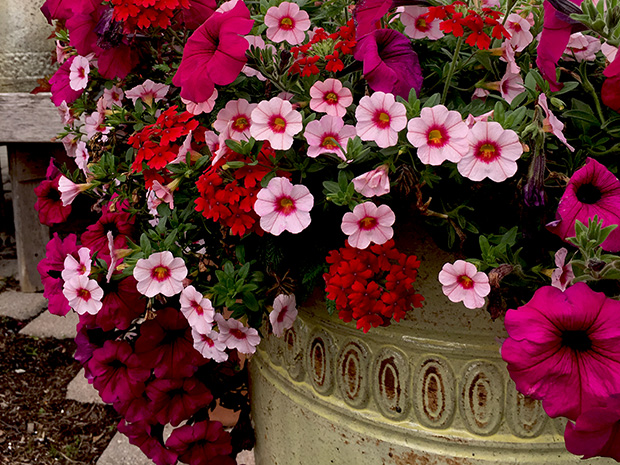It seems obvious but bears mentioning. Select plants that have the same sunlight requirements!
Traditional container gardens call for the tallest plant in the middle, medium sized plants around the tall plant, and shortest or cascading plants on the edges. Looking for design inspiration? Proven Winners has loads of container recipes! Tap to take a look!
Try to avoid pots that are less than 10″. Outdoors it will be fairly difficult to keep them well-watered once high summer arrives. Smaller pots also restrict the roots too much. If using terracotta pottery, soak the pot in water for a day before planting. Terracotta dries out faster than other containers so decide beforehand if you’re up for a bit more watering.
Make sure you select containers with drainage. Planting in vessels with no drainage holes will quickly rot the roots of your plants. If you’re set on a container that has no drainage, it’s fairly easy to drill a hole using a masonry bit.
Putting newspaper on the inside bottom of the container when you’re planting keeps soil from leaking out during watering. After a while, the roots will hold onto the soil and the paper will have degraded.
Use a light potting mix that allows good drainage. Most commercial mixes have the correct properties for containers.
If you choose to make your own potting mix out of compost, be sure to add some amendments. Following is Cornell’s recipe for potting mix: 2 parts garden soil, 2 parts compost, 1 part sharp (builder’s) sand, 1 part vermiculite or perlite. Never use soil from the ground in a container.
If you don’t buy a mix with fertilizer already in it, you’ll want to feed your containers every other time you water.
If you’re putting veggies or herbs in your plantings, go for an organic potting mix and fertilize with organic vegetable food.
Spaghnum moss will help retain moisture when putting hanging baskets together. Line the basket with the moss before adding your soil.
It’s a good idea to set your pots on stones or wood for better drainage.
Most containers will need monitoring when in the afternoon sun. The best way to check whether or not a pot needs water is by lifting a bit. You’ll see how heavy it is when well-watered. When it becomes light to lift, give it a thorough watering. For hanging baskets, just push up a little on the bottom of the container. The same principle applies. Going by a watering schedule can lead to disappointment! Heat and humidity conditions can be different every day and the plants will respond accordingly.

